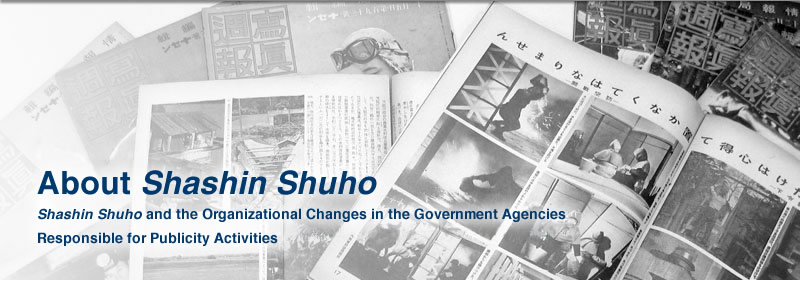 |
World War I is said to have made many in Japan aware of the importance of conducting government publicity activities. The conflict began in 1914 and lasted for over four years, involving the Western powers and many other nations. It was a total war, both militarily and economically, in which the people of each nation involved were called on to actively contribute to the war effort. In addition, the nature of the war reinforced recognition of the need to make people in enemy countries lose their will to fight, as well as the importance of gaining the support of countries not directly involved in the conflict. Influenced by these internal and external factors, many participating countries carried out active publicity campaigns.
In response to these developments, the Japanese government at that time recognized the significance of conducting publicity activities. The government established the Newspaper Group (the predecessor to the Army Intelligence Department) in 1919 immediately after the end of the war, placing it under the direct control of the Minister of War, besides regulations for the Ministry of War (regulations for the names, structure, and authority of government organizations). In addition, the Intelligence Department was unofficially established within the Ministry of Foreign Affairs in 1920, and then designated as an official government organization in 1921 through the promulgation of government regulations. Later on in 1924, the Naval Affairs Promotion Committee was also established within the Ministry of the Navy. In this way, the government set up special divisions responsible for conducting publicity activities.
Document 1 shows the diplomatic cables Foreign Minister Yasuya Uchida sent to Japanese ambassadors in Britain, France, Italy, and the United States in 1920 to order the ambassadors to obtain film reels of the motion pictures produced by participating countries during World War I, and the ambassadors' response to the order. This document reveals that the Ministry of Foreign Affairs was aware that nations involved in the conflict produced motion pictures as a propaganda tool to disseminate information during the war about the fighting on the front and industrial activities. It also shows that this awareness underlined the ministry's efforts to obtain film reels of these motion pictures to publicize the state of the war to people in Japan.
Document 2 shows an original manuscript signed by the Emperor concerning the change in the government organization of the Ministry of Foreign Affairs that was made when the Intelligence Department was officially established within the Ministry. This document stipulated that the Intelligence Department was to be established within the Ministry of Foreign Affairs, and that the Vice-Minister for Foreign Affairs, an imperial appointee (high-ranking official in a position similar to a minister or vice-minister under the Meiji Constitution), or an official personally appointed by the Emperor (high-ranking official from among the imperial appointees that were appointed by imperial ordinances under the Meiji Constitution) from within the Foreign Affairs Department was to be appointed as the Intelligence Department Director.
Document 3 shows a compilation of diplomatic cables sent in 1923 from the newly established Intelligence Department of the Ministry of Foreign Affairs to its overseas diplomatic establishments, along with the responses of these establishments to the orders they received. In these cables, the ministry instructed the establishments to effectively use the photos it had taken of general and current affairs in Japan and have them published in local newspapers and magazines. This document shows that, while the Intelligence Department of the Ministry of Foreign Affairs issued instructions to make the full use of of photos about Japan to make people in foreign countries familiar with contemporary events in Japan, it also ordered its overseas diplomatic establishments to provide the head office with reports on articles about the political, diplomatic, economic, and social affairs of countries around the world, and if possible submit clear photographs together with these reports. The order was made in response to the trend in which newspapers in Japan at this time gave great priority to the society section and ran interesting articles about foreign affairs featuring relevant pictures, and to introduce Japanese people to foreign affairs through the society section of domestic newspapers by “taking advantage of such a trend in the future.” Incidentally, some of the reports from overseas countries contained attachments of photos about Japan clipped from local newspapers.
Document 4 shows a request sent by Nikkatsu Corporation in 1927 asking for the Ministry of the Navy to cooperate along with the Ministry of War, the General Staff Office, the Ministry of Foreign Affairs, and the Home Ministry in the production of a military movie. In this document, Nikkatsu said that it had been “making small contributions to the indoctrination of militaristic ideals among ordinary people” for many years through the production of military movies, and requested for the Ministry of the Navy to dispatch three project advisors to help produce a new unprecedented film about the Japanese military that “could be described as means for mobilizing the entire nation.”
Document 5 shows how the Ministry of the Navy dealt with the request made by Nikkatsu in Document 4. In response to Nikkatsu’s request, the Ministry of the Navy made the Naval Affairs Promotion Committee, which was in charge of publicity activities, draw up a draft of a reply reflecting the thoughts of the Ministry of War, the Ministry of Foreign Affairs, and the Home Ministry (the second image) concerning the merits of dispatching project advisors. In drafting the reply, the Naval Affairs Promotion Committee held a phone conference with the Newspaper Corps of the Ministry of War, which was in charge of the publicity activities for the Army, and confirmed that the Army “was not thinking about dispatching any project advisors (the fifth image). This document provides us with valuable insight into the communications between the Navy and Army’s publicity branches.
|

